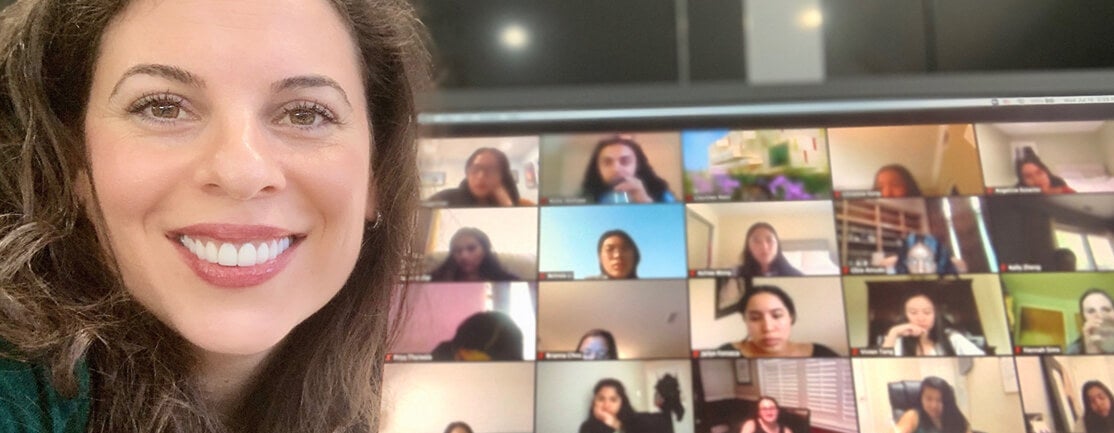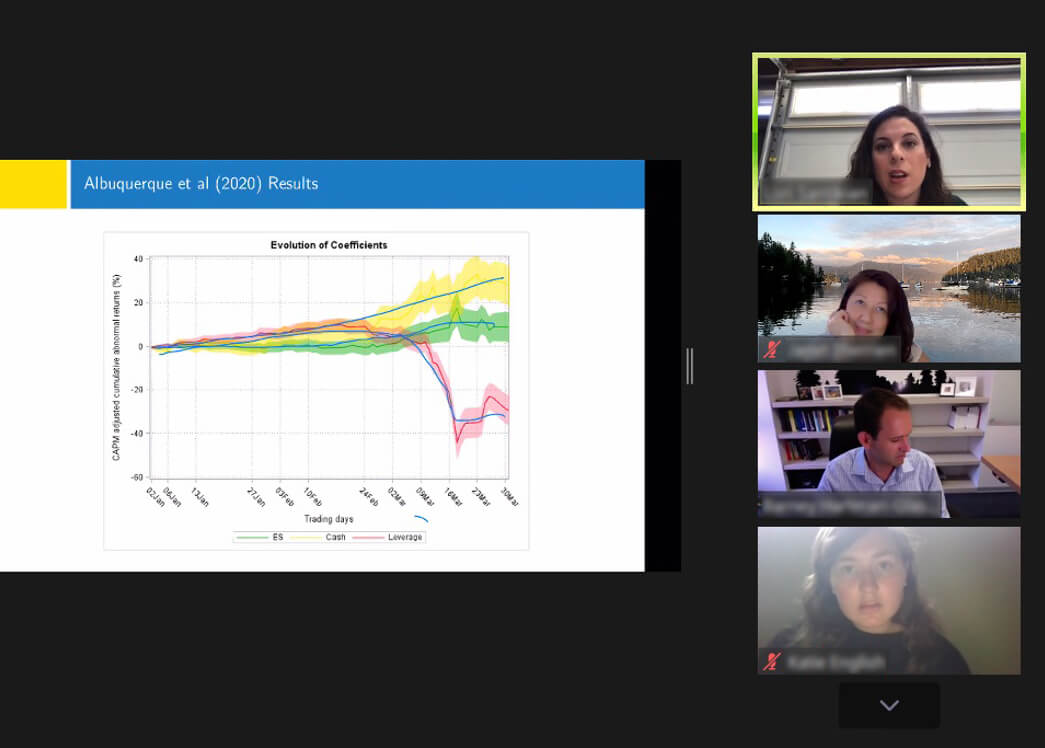Fink Center for Finance and Girls Who Invest Help Close the Gender Gap
Fink Center for Finance and Girls Who Invest Help Close the Gender Gap

Associate Adjunct Professor Lori Santikian, faculty director of the Fink Center for Finance, conducted sessions with Girls Who Invest scholars via Zoom
- UCLA Anderson’s Fink Center for Finance hosts the nonprofit Girls Who Invest to help close the gender gap in investment careers
- Prominent faculty teach intensive curriculum to college sophomores, who are mentored by industry professionals
- Fink Center faculty director Lori Santikian says, “Our goal is to empower these talented young scholars to pursue their interest in finance with boundless aspiration"
Summer coursework may have moved to a virtual experience in 2020, but that didn’t stop the UCLA Anderson School of Management from successfully launching its first year of hosting Girls Who Invest, a nonprofit organization that operates and administers its program at top business schools.
Through intensive summer programs in finance and investing for college sophomores, Girls Who Invest began in 2015 with a mission to increase the number of women in portfolio and asset management.
And since 2016, more than 800 young women have participated in their flagship and online summer programs. Girls Who Invest in-person scholars complete a four-week tuition-free investment training, followed by a six-week paid internship at one of more than 100 leading financial partners.
Creating a pipeline for young women to gain leadership roles throughout the investment industry, Girls Who Invest has an ambitious goal: that women manage 30% of the world’s investable capital by 2030. While women are largely underrepresented in a variety of industries, the disparity is glaring in the investment world. Studies show that less than 10% of North American mutual fund portfolio managers and only 6% of U.S. chief investment officers are women.
To close that gender gap, Girls Who Invest, which began at the Wharton School of the University of Pennsylvania, developed and runs a program offering intensive classes taught by prominent faculty members. In the summer of 2020, the UCLA Anderson Fink Center for Finance hosted the Girls Who Invest program at UCLA Anderson remotely.
“I founded Girls Who Invest to inspire and prepare young women to pursue careers in investment management. Our impact has been tremendous, which is very exciting,” says Seema R. Hingorani, founder and chair of Girls Who Invest. “While there’s still much work to be done, I’m encouraged by how leading investment firms have been stepping up and recognizing that there is amazing female talent in all places. The support of faculty at top schools, including UCLA Anderson, has strengthened our momentum as we look to bring even more diversity to the investment industry by widening our reach to young women from coast to coast.”
Lori Santikian, associate adjunct professor of finance and strategy and the faculty director of the Laurence and Lori Fink Center for Finance, says there were several reasons she was excited for the center to host Girls Who Invest at UCLA Anderson. “The Fink Center builds bridges between research, practice and professionals in the field of finance,” says Santikian. “Girls Who Invest parallels the work we do to connect graduate students with research and training by our world-renowned faculty, expose them to insights from practitioners and inspire new interactions and ideas.”
The nationwide program is a diverse one: 20% of its participants to date have been historically underrepresented minority students and 23% have come from socioeconomically disadvantaged backgrounds. “Asset managers have realized that investment teams with diverse backgrounds are better poised to generate superior returns,” Santikian says. “This is because all competitive advantage relies on uniqueness — the ability to see and do what others cannot. Supporting a diverse culture and pipeline of talent in finance is a top priority for the Fink Center. Our goal is to empower these talented young scholars to pursue their interest in finance with boundless aspiration.”
Girls Who Invest selects the participating scholars and engages various faculty to teach in the program. In 2020, it approached UCLA Anderson about hosting a cohort on the West Coast. Santikian and Barney Hartman-Glaser, a UCLA Anderson associate professor of finance, served as co-academic leads, adapting the curriculum and recruiting their faculty colleagues. “We sought to leverage the expertise of our world-class finance faculty while providing a comprehensive program that mirrored what we cover with our graduate students,” says Hartman-Glaser. “I was very impressed by the scholars’ ability to absorb such a wealth of material in such a short time. However, I was even more impressed by their curiosity and capacity to think critically about the topics we covered.”
Participation by faculty members in this summer program was voluntary, but with such a compelling mission, more professors expressed interest to get involved than there were slots available.

Anderson’s GWI instructors educated a diverse cohort of students
“I was inspired to reach a different audience with little exposure or experience in finance as undergraduates, versus our MBAs. This makes teaching them particularly fun and interesting,” says Tyler Muir, an associate professor of finance who taught an introduction to hedge funds in the program. “I think undergraduates sometimes have the impression that finance is either intimidating or boring, and I hope I can show them neither is the case.”
Avanidhar Subrahmanyam, distinguished professor of finance and Anderson’s Goldyne and Irwin Hearsh Chair in Money and Banking, was motivated to impart some knowledge to a group historically underrepresented on Wall Street and throughout the industry.
“The opportunity to introduce (behavioral finance) to bright young minds was impossible to pass up,” Subrahmanyam says. “The best part of the program was the insightful questions from many of the students. Their acumen and insight were as good, and at times better, than the questions I received from more advanced MBA students and even Ph.D. students.”
Though classes and internships were intended to be held in person, GWI quickly adapted to a remote model. Anderson faculty had begun to get a sense of what makes a virtual class successful throughout UCLA’s spring quarter, and they converted those lessons into a platform for the scholars in the summer.
“I was very grateful (my professors) were so caring and so patient. They taught in a way that someone with no background in finance was able to not only understand and learn about the concepts, but could also learn about the big picture,” Micaela Soria Robles, an international relations student from Stanford University, says of the program. Born in La Paz, Bolivia, Robles moved to Los Angeles in 2009. She applied to GWI out of curiosity about how investment, asset management and finance can work toward positive societal impact.
In addition to completing intensive, high-level coursework assigned by GWI faculty, participants worked closely with GWI mentors throughout their investment internships and they gained real-world insights from experienced investment industry professionals.
“I realized that there was such a huge need for women in finance, and I wanted to be a part of it. The more that I learned about the program, the more excited I was to apply,” says Katie English, a rising junior from the College of William and Mary who is studying finance and philosophy. “What I loved about Girls Who Invest was that you could get a mix of academic theory and practical application. Speakers came in and they would talk about the day-to-day of what it’s actually like to be a woman in finance.”
After taking courses on such topics as the fundamentals of finance and applications for investing, GWI scholars applied their training to an internship at leading asset management firms. Scholars also collaborated on a capstone project, in which they created a stock recommendation for a firm partnering with the course; in 2020 it was Etsy. At the end of the GWI course, they presented their valuation and stock recommendation to a panel of investment committee members from the industry and to their peers.
“In four weeks, they succeeded in a remarkable transformation from novice students to polished investment analysts presenting insightful recommendations. It was a joy to observe, and a direct testament to their talent, focus and support of one another. Even in the virtual environment, the camaraderie among the scholars was palpable,” Santikian notes.
Some of the young women were so inspired by the program’s lessons that they took their experiences and knowledge back to their own campuses. Julianna Wright, an economics and math student at Wellesley College, founded her own student organization: Wellesley for Asset Management and Finance.
“Being exposed to so many different perspectives, and learning from women who go to a business school or other liberal arts colleges — it’s unique,” Wright says. “And at the end of the day, we’re going into an industry that still has some work (to do) in terms of diversity. It’s nice to know that you’re not going at it alone.”
Ultimately, one of the most distinctive aspects of the program is the emphasis on building a supportive community of young women, academics and investment professionals, all seeking to diversify a traditionally male-dominated industry.
“I feel like now I have a family, or a team of people, that is always going to be there to support not only each other’s careers, but also this initiative toward addressing gender inequality in the finance industry,” Robles says.
Sowmya Magham, who studies finance and informatics at the University of Washington, also discovered a unique cohort of fellow-scholars-turned-close-friends through GWI.
“We really used all the platforms that we were provided to be able to talk to each other and make the connections that we would have made if it was in person,” Magham says. “Everyone was just so kind, understanding, supportive — and they challenged me in the best way possible.”
While there’s still a long way to go to diversify the future of the investment industry, educational institutions can play a role in unclogging the pipeline of young leaders. Santikian and Hartman-Glaser hope that the Girls Who Invest program returns to UCLA Anderson year after year.
Voices of Future Investors
Graduates of the 2020 Girls Who Invest Summer Intensive Program hosted by UCLA Anderson resumed studies at their home universities fired up about finance and their newfound community of scholars:
- Natasha Hamid, University of Michigan: “The classes, the speakers and especially the internship have shown me how fascinating and fulfilling a career as an investor could be.
- Angelina Susanto, University of Pennsylvania: “GWI really teaches you the importance of women and diversity in investing, and how interesting, complex and wide the field is.”
- Riya Sheth, Rutgers University: “Interacting with these powerful and successful women has allowed me to envision myself in these roles and fueled my passion to not only enter this industry, but make space for other women.”
- Danielle Mishler, University of Chicago: “A huge thank you to my UCLA cohort for the inspiration, the support and the late-night Zoom laughs I will always treasure.”
- Malikah Nathani, University of Washington: “A community of scholars is probably one of the biggest gifts Girls Who Invest could have given me.”